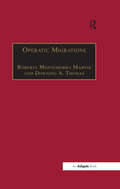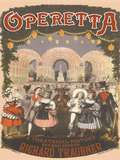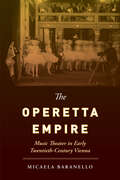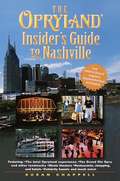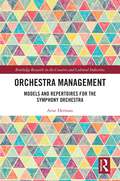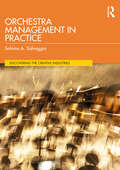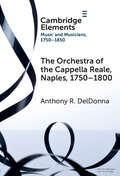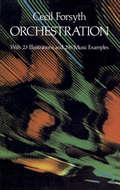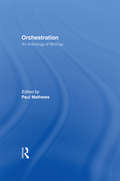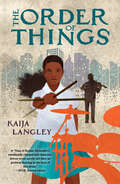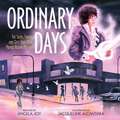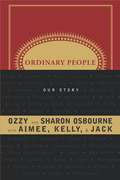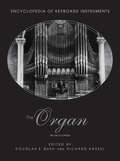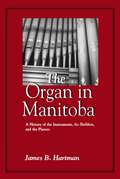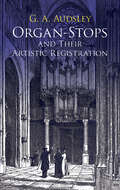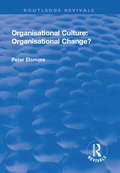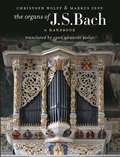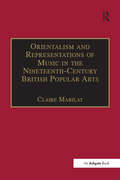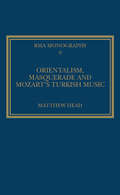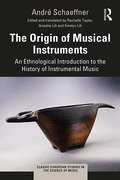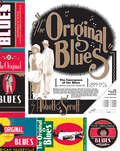- Table View
- List View
Operatic Migrations: Transforming Works and Crossing Boundaries
by Roberta Montemorra Marvin Downing A. ThomasThis volume takes an interdisciplinary approach to studying a wide range of subjects associated with the creation, performance and reception of 'opera' in varying social and historical contexts from the eighteenth to the twentieth centuries. Each essay addresses migrations between genres, cultures, literary and musical works, modes of expression, media of presentation and aesthetics. Although the directions the contributions take are diverse, they converge in significant ways, particularly with the rebuttal of the notion of the singular nature of the operatic work. The volume strongly asserts that works are meaningfully transformed by the manifold circumstances of their creation and reception, and that these circumstances have an impact on the life of those works in their many transformations and on a given audience's experience of them. Topics covered include transformations of literary sources and their migration into the operatic genre; works that move across geographical and social boundaries into different cultural contexts; movements between media and/or genre as well as alterations through interpretation and performance of the composer's creation; the translation of spoken theatre to lyric theatre; the theoretical issues contingent on the rendering of 'speech' into 'song'; and the transforming effects of aesthetic considerations as they bear on opera. Crossing over disciplinary boundaries between music, literary studies, history, cultural studies and art history, the volume enriches our knowledge and understanding of the operatic experience and the works. The book will therefore appeal to those working in the field of music, literary and cultural studies, and to those with a particular interest in opera and musical theatre.
Operetta: A Theatrical History
by Richard Traubner"Operetta: A Theatrical History" is considered the classic history of this important musical theater form. Traubner's book, first published in 1983, is still recognized as the key history of the people and productions that made operetta a worldwide phenomenon. Beginning in mid-19th century Europe, the book covers all of the key developments in the form, including the landmark works by Strauss and his followers, Gilbert & Sullivan, Franz Lehar, Rudolf Friml, Victor Herbert, and many more. The book perfectly captures the champagne-and-ballroom atmosphere of the greatest works in the genre. It will appeal to all fans of musical theatre history.
The Operetta Empire: Music Theater in Early Twentieth-Century Vienna
by Micaela Baranello"When the world comes to an end," Viennese writer Karl Kraus lamented in 1908, "all the big city orchestras will still be playing The Merry Widow." Viennese operettas like Franz Lehár's The Merry Widow were preeminent cultural texts during the Austro-Hungarian Empire's final years. Alternately hopeful and nihilistic, operetta staged contemporary debates about gender, nationality, and labor. The Operetta Empire delves into this vibrant theatrical culture, whose creators simultaneously sought the respectability of high art and the popularity of low entertainment. Case studies examine works by Lehár, Emmerich Kálmán, Oscar Straus, and Leo Fall in light of current musicological conversations about hybridity and middlebrow culture. Demonstrating a thorough mastery of the complex early twentieth-century Viennese cultural scene, and a sympathetic and redemptive critique of a neglected popular genre, Micaela Baranello establishes operetta as an important element of Viennese cultural life—one whose transgressions helped define the musical hierarchies of its day.
The Opryland Insider's Guide to Nashville
by Susan ChappellNashville is an attraction of the tourists. Susan Chappell, a top Nashville writer has information about this place- the best hotels, the music venues, theaters, a schedule of annual events, historic day trips, river cruises, and specialty shops.
Orchestra Management: Models and Repertoires for the Symphony Orchestra (Routledge Research in the Creative and Cultural Industries)
by Arne HermanEvery orchestra in the world oscillates between crisis and survival. This perpetual movement makes innovation, both in organizational form and in artistic product, vital to the sustainability of the symphony orchestra. Based on case study research in Flanders, Amsterdam and London, this book reflects on the sustainability crisis of the orchestra by framing it as a legitimacy crisis that affects both the orchestra’s artistic and organizational identity. The aim of this book is to explore the dynamics between various and often conflicting factors in the orchestra’s quest for survival, and to show how these organizational dynamics relate to the orchestra’s repertoire. By highlighting the importance of every organization’s specific environment to which it needs to adapt, this book illustrates that the orchestra field is not a field that relies on best practices. The book reflects on conventional as well as innovative orchestra models, making the comparative point of view relevant for academic or practice-based researchers, orchestra managers, policymakers and subsidizing bodies interested in sustainable and future-oriented orchestra management.
Orchestra Management in Practice (Discovering the Creative Industries)
by Salvino A. SalvaggioIntroducing the business models, organisational structures, and fundamentals of orchestras, this book takes readers on a journey through the evolution of orchestra management. The author explores the dynamics between artistic excellence and financial sustainability. Key aspects of orchestra management are examined in detail, including artistic programming, strategic planning, financial and compliance/legal matters, audience development, resilience and adaptability, governance and board relations, diversity and inclusion, partnerships, and the role of technology and innovation. With actionable resources, such as checklists, templates, and frameworks, for current and future orchestra leaders and managers, this comprehensive guide empowers readers in education and practice to navigate the complexities of orchestra management confidently and effectively.
The Orchestra of the Cappella Reale, Naples, 1750–1800 (Elements in Music and Musicians 1750-1850)
by null Anthony R. DelDonnaThe most prestigious musical ensemble of early-modern Naples remained the Royal Chapel or Cappella Reale di Palazzo. Conceived to serve directly the ruling authority of the capital city – whether the viceroy (Spanish or Austrian) or monarchs (Carlo di Borbone then Ferdinando) – membership in this elite organization offered prestige, financial security, and access to the broader networks of music culture in Naples, attracting the best musicians within and beyond the physical confines of the capital. This Element introduces readers to the largely unknown history of the Neapolitan Cappella Reale in the second half of the eighteenth century. It is based on primary sources, reconstructing the entire personnel of the ensemble (1750–99), recovering previously unstudied contractual agreements, offering details about the musicians while also examining the original music of the principal musicians of the orchestra.
The Orchestral Music of Michael Tippett
by Thomas SchuttenhelmWith extracts from the composer's letters, writings, interviews and broadcasts, and supported by evidence from his sketchbooks and manuscripts, The Orchestral Music of Michael Tippett explores Tippett's intentions and argues that the experiences that triggered his creative impulses are integral to understanding his music. In his discussion of Tippett's creative process, Thomas Schuttenhelm attempts to recapture the circumstances under which Tippett's orchestral works were created, to document how his visionary aspirations were developed and sustained throughout the creative cycle, and to chart how conception was transmuted from idea through to performance. Analysing Tippett's orchestral works throughout his long career, from the Symphonic Movement of 1931 to his final masterpiece The Rose Lake in 1991–3, Schuttenhelm explores each work in detail to provide a comprehensive commentary on one of the most influential British composers of the twentieth century.
The Orchestral Revolution
by Emily I. DolanThe Orchestral Revolution explores the changing listening culture of the eighteenth and early nineteenth centuries. Delving into Enlightenment philosophy, the nature of instruments, compositional practices and reception history, this book describes the birth of a new form of attention to sonority and uncovers the intimate relationship between the development of modern musical aesthetics and the emergence of orchestration. By focusing upon Joseph Haydn's innovative strategies of orchestration and tracing their reception and influence, Emily Dolan shows that the consolidation of the modern orchestra radically altered how people listened to and thought about the expressive capacity of instruments. The orchestra transformed from a mere gathering of instruments into an ideal community full of diverse, nuanced and expressive characters. In addressing this key moment in the history of music, Dolan demonstrates the importance of the materiality of sound in the formation of the modern musical artwork.
Orchestration: Music Book Index (Dover Books on Music)
by Cecil Forsyth"For its time the most comprehensive treatment of the subject." -- New Grove Dictionary of Music and MusiciansBefore the 17th century, composers seldom indicated in their music whether the composition was to be performed by a particular combination of voices or instruments. Then in 1607 Monteverdi made a well-known suggestion for the orchestration of his opera Orfeo. And as the Baroque era unfolded, the concept of orchestrations began to evolve, achieving a notable clarity and the acceptance of a keyboard instrument as an integral part of the ensemble.Toward the middle of the 18th century, stylistic changes in instrumental music, e.g. styles that emphasized a single melodic line, directly affected methods of orchestration; while in the 19th century, orchestrations became an ever more vital factor in the composer's technique, a stylistic determinant that places a wealth of possibilities at his disposal. Finally, in the early 18th century, increasing awareness of the importance of internal balance, certain ideals of blended sound, and firmly established instrumental characteristics enabled orchestration to take its place as an academic discipline beside harmony and counterpoint.In this classic manual, a noted English composer describes 57 orchestral instruments (ca. 1914) tracing their origins, development, and status at the beginning of World War I. Not only are the history and evolution of each instrument fully discussed, the author also explores the techniques of each instrument, as well as players' impressions about what they must play. The result is an unparalleled insight into the inner working of an orchestra -- a vivid impression of what it is like to be a violinist, clarinetist, trombonist, or other orchestral player.While there have been numerous developments in instrumental technique on an individual basis since the book's first publication, most of what Forsyth says is still valid. Writing with wit, grace, and good sense, Forsyth created a formidably thorough, comprehensive, and informative text that has instructed and influenced generations of composers, conductors, musicians, and musicologists.
Orchestration: An Anthology of Writings
by Paul MathewsOrchestration: An Anthology of Writings is designed to be a primary or ancillary text for college-level music majors. Although there are several 'how to' textbooks aimed at this market, there is little available that traces the history of orchestration through the writings of composers themselves. By collecting writings from the ninenteenth century to today, Mathews illuminates how orchestration has grown and developed, as well as presenting a wide variety of theories that have been embraced by the leading practitioners in the field. The collection then traces the history of orchestration, beginning with Beethoven's Orchestra (with writings by Berlioz, Wagner, Gounod, Mahler, and others), the 19th century (Mahler, Gevaert, Strauss) the fin de siecle (on the edge of musical modernism; writings by Berlioz, Jadassohn, Delius, and Rimsky Korsakov), early modern (Busoni, Schoenberg, Stravinsky, Grainger, and others), and high modern (Carter, Feldman, Reich, Brant). Many of these pieces have never been translated into English before; some only appeared in small journals or the popular press and have never appeared in a book; and none have ever been collected in one place. The study of orchestration is a key part of all students of music theory and composition. Orchestration provides a much needed resource for these students, filling a gap in the literature.
The Order of Things
by Kaija LangleyA heart-rending novel-in-verse about a girl beginning to learn it is possible to go on even after a great loss.Eleven-year-old April Jackson loves playing the drums, almost as much as she loves her best friend, Zee, a violin prodigy. They both dream of becoming professional musicians one day. When Zee starts attending a new school that will nurture his talent, April decides it&’s time for her to pursue her dreams, too, and finally take drum lessons. She knows she isn&’t very good to start, but with Zee&’s support, she also knows someday she can be just as good as her hero, Sheila E., and travel all around the world with a pair of drumsticks in her hand.When the unthinkable happens and Zee suddenly passes away, April is crushed by grief. Without Zee, nothing is the way it&’s supposed to be. Zee's Dad isn't delivering the mail for his postal route like he should. April's Mom is suddenly dating someone new who is occupying too much space in their lives. And every time April tries to play the drums, all she can think about is Zee.April isn't sure how to move on from the awful feeling of being without Zee. Desperate to help Papa Zee, she decides to secretly deliver the mail he&’s been neglecting. But when on her route she discovers a classmate in trouble, she doesn&’t second guess what she knows is the right thing to do.
Ordinary Days: The Seeds, Sound, and City That Grew Prince Rogers Nelson
by Angela JoyA rhythmic, striking picture book biography of legendary singer/songwriter/performer Prince.Before he became a legend, he was just a boy… On an ordinary day, you could see him. A young boy named Prince Rogers Nelson, who had parents who fought, nowhere to call home, and a collection of memories turned into sound: the shouts of anger, the purr of pigeons, the roar of cars down a busy Minneapolis street, and the whisper of cold wind on budding lilac bushes. Other sounds joined in as he taught himself to play the guitar, piano, drums, and much more, leading to the day this ordinary boy began to make music—and became extraordinary. Black Is a Rainbow Color and Choosing Brave author Angela Joy’s exquisite words harmonize with acclaimed illustrator Jacqueline Alcántara’s sweeping art to create a tender, profound look into music icon Prince's early life and the moments that shaped him.Ordinary Days also includes an extensive author’s note and playlist of recommended Prince songs suitable for young listeners.
Ordinary People
by Family OsbourneIn their own words (and we all know how colorful those can be), the five members of the notorious Osbourne clan tell the amazing story of the first family of rock. OZZY talks about his first beer, his legendary career,and why he's the only sane member of the Osbourne family. SHARON explains the root of her shopaholic nature, the ups and downs of being married to Ozzy, and what it's like to battle cancer and host a talk show. AIMEE reveals why she opted out of MTV's The Osbournes, why she thinks her mother's in denial, and why her father destroyed himself with drugs. KELLY offers cutting thoughts on sibling relationships and growing up Osbourne as well as on life as a fledgling rock star. JACK shares stories about life without privacy ("What's privacy?") and his stint in rehab -- and claims he's the only sane one in the family. IF YOU THOUGHT YOU ALREADY KNEW THE OSBOURNES, THINK AGAIN!
The Organ: An Encyclopedia
by Richard KasselThe Encyclopedia of Organ includes articles on the organ family of instruments, including famous players, composers, instrument builders, the construction of the instruments, and related terminology. It is the first complete A-Z reference on this important family of keyboard instruments. The contributors include major scholars of music and musical instrument history from around the world.
The Organ in Manitoba: A History of the Instruments, the Builders, and the Players
by James B. HartmanPipe organs were once a central (and sometimes hotly debated) part of Manitoba's cultural life. The Organ in Manitoba portrays that history--the instruments, builders, players and critics--from the date of the earliest known installations to the 1990s, and includes information on musical organizations such as the Royal Canadian College of Organists. It documents over a century of evolution and changes, from concepts of tonal design to styles of musical commentary and tastes, and includes an inventory of installations and specifications for over 100 organs. Well-illustrated with photographs and excerpts from historical reviews and other documents, it will be of interest to musicians, teachers, and music, church, and cultural historians.
Organ-Stops and Their Artistic Registration (Dover Books On Music: Instruments)
by George Ashdown AudsleyThis 1921 classic by a renowned organ builder provides organists and all those interested in the instrument with a guide to its numerous stops, among them bassoon, bass tuba, cymbal, double trumpet, oboe, piccolo, viola da gamba, and xylophone. The text supplies various names of each stop in different languages, traces their origins, and describes their construction, tonal characteristics, and value in artistic combination and registration. A fascinating book about the "Monarch of all Instruments" for students, teachers, and professional musicians. A "must-have" for the organist's library. Introduction by Rollin Smith. 5 plates of illustrations.
Organisational Culture: Organisational Change? (Routledge Revivals)
by Peter ElsmoreThis title was first published in 2001. When organizational change occurs, members of the organization can feel insecure in the face of a seemingly uncertain future. This work investigates the links between organizational culture and organizational change by looking at two businesses that have been privatized - British Gas and British Telecom - and the processes surrounding the ways these organizations changed in the mid 1990s. It includes interviews with middle-ranking and senior officals, illustrating that anguish is experienced not only by those on the lower rungs of the corporate ladder.
Organising Music
by Nic Beech Charlotte GilmoreOrganisational theorists have become increasingly interested in the creative industries, where practices that are commonplace are of particular interest to organisations in other sectors as they look for new ways to enhance performance. Focusing on the music industry, this book sets up a unique dialogue between leading organisational theorists and music professionals. Part I explores links between organisation theory and the creative industries literature, concentrating on practices of organising and knowledge mobilisation, followed by an in-depth discussion of key theoretical concepts by subject experts. Part II provides a diverse range of 'tales from the field', including examples from classical orchestras, folk, indie and punk. The concluding chapter examines the shared dialogue to reveal what practice in the musical field can learn from organisational theory, and vice versa. This innovative book will interest graduate students and researchers in the fields of organisation studies, music management and the creative industries.
The Organs of J.S. Bach: A Handbook
by Lynn Edwards Butler Christoph Wolff Markus ZepfThe Organs of J. S. Bach is a comprehensive and fascinating guide to the organs encountered by Bach throughout Germany in his roles as organist, concert artist, examiner, teacher, and visitor. Newly revised and updated, the book's entries are listed alphabetically by geographical location, from Arnstadt to Zschortau, providing an easy-to-reference overview. Includes detailed organ-specific information: high-quality color photographs each instrument's history, its connection to Bach, and its disposition as Bach would have known it architectural histories of the churches housing the instruments identification of church organists Lynn Edwards Butler's graceful translation of Christoph Wolff and Markus Zepf's volume incorporates new research and many corrections and updates to the original German edition. Bibliographical references are updated to include English-language sources, and the translation includes an expanded essay by Christoph Wolff on Bach as organist, organ composer, and organ expert. The volume includes maps, a timeline of organ-related events, transcriptions of Bach's organ reports, a guide to examining organs attributed to Saxony's most famous organ builder Gottfried Silbermann, and biographical information on organ builders. Publication of this volume is supported by the American Bach Society.
Orientalism and Musical Mission: Palestine and the West
by Rachel Beckles WillsonOrientalism and Musical Mission presents a new way of understanding music's connections with imperialism, drawing on new archive sources and interviews and using the lens of 'mission'. Rachel Beckles Willson demonstrates how institutions such as churches, schools, radio stations and governments, influenced by missions from Europe and North America since the mid-nineteenth century, have consistently claimed that music provides a way of understanding and reforming Arab civilians in Palestine. Beckles Willson discusses the phenomenon not only in religious and developmental aid circles where it has had strong currency, but also in broader political contexts. Plotting a historical trajectory from the late Ottoman and British Mandate eras to the present time, the book sheds new light on relations between Europe, the USA and the Palestinians, and creates space for a neglected Palestinian music history.
Orientalism and Representations of Music in the Nineteenth-Century British Popular Arts (Music In Nineteenth-century Britain Ser.)
by Claire MabilatRepresentations of music were employed to create a wider 'Orient' on the pages, stages and walls of nineteenth-century Britain. This book explores issues of orientalism, otherness, gender and sexuality that arise in artistic British representations of non-European musicians during this time, by utilizing recent theories of orientalism, and the subsidiary (particularly aesthetic and literary) theories both on which these theories were based and on which they have been influential. The author uses this theoretical framework of orientalism as a form of othering in order to analyse primary source materials, and in conjunction with musicological, literary and art theories, thus explores ways in which ideas of the Other were transformed over time and between different genres and artists. Part I, The Musical Stage, discusses elements of the libretti of popular musical stage works in this period, and the occasionally contradictory ways in which 'racial' Others was represented through text and music; a particular focus is the depiction of 'Oriental' women and ideas of sexuality. Through examination of this collection of libretti, the ways in which the writers of these works filter and romanticize the changing intellectual ideas of this era are explored. Part II, Works of Fiction, is a close study of the works of Sir Henry Rider Haggard, using other examples of popular fiction by his contemporary writers as contextualizing material, with the primary concern being to investigate how music is utilized in popular fiction to represent Other non-Europeans and in the creation of orientalized gender constructions. Part III, Visual Culture, is an analysis of images of music and the 'Orient' in examples of British 'high art', illustration and photography, investigating how the musical Other was visualized.
Orientalism, Masquerade and Mozart's Turkish Music
by Matthew HeadMatthew Head explores the cultural meanings of Mozart's Turkish music in the composer's 18th-century context, in subsequent discourses of Mozart's significance for 'Western' culture, and in today's (not entirely) post-colonial world. Unpacking the ideological content of Mozart's numerous representations of Turkey and Turkish music, Head locates the composer's exoticisms in shifting power relations between the Austrian and Ottoman Empires, and in an emerging orientalist project. At the same time, Head complicates a presentist post-colonial critique by exploring commercial stimuli to Mozart's turquerie, and by embedding the composer's orientalism in practices of self-disguise epitomised by masquerade and carnival. In this context, Mozart's Turkish music offered fleeting liberation from official and proscribed identities of the bourgeois Enlightenment.
The Origin of Musical Instruments: An Ethnological Introduction to the History of Instrumental Music (Classic European Studies in the Science of Music)
by André SchaeffnerThe work of French musicologist, ethnologist and critic Andre Schaeffner (1895– 1980) grew out of his first organological studies of the history of Western classical instruments in the late 1920s and encapsulated in his wide-ranging Origine des instruments de musique, which captures his studies in Paris between 1931 and 1936. Almost 80 years after its first publication, the scientific relevance and influence of Schaeffner’s primary hypothesis—that the origins of music can be traced to the human body through gesture, dance and the movements in the use of musical instruments and their ancestor tools—remains pertinent in fields which have returned to informed speculative and empirical research on the origins of music. This first English edition is accompanied by editorial footnotes and introductory texts, and the influence of Schaeffner’s thought on several generations of musicologists makes his work an essential piece of reading for ethnomusicologists, music psychologists, organologists and musicologists interested in the history of their field.
The Original Blues: The Emergence of the Blues in African American Vaudeville (American Made Music Series)
by Lynn Abbott Doug SeroffBlues Book of the Year —Living BluesAssociation of Recorded Sound Collections Awards for Excellence Best Historical Research in Recorded Blues, Gospel, Soul, or R&B–Certificate of Merit (2018)2023 Blues Hall of Fame Inductee - Classic of Blues Literature categoryWith this volume, Lynn Abbott and Doug Seroff complete their groundbreaking trilogy on the development of African American popular music. Fortified by decades of research, the authors bring to life the performers, entrepreneurs, critics, venues, and institutions that were most crucial to the emergence of the blues in black southern vaudeville theaters; the shadowy prehistory and early development of the blues is illuminated, detailed, and given substance.At the end of the nineteenth century, vaudeville began to replace minstrelsy as America’s favorite form of stage entertainment. Segregation necessitated the creation of discrete African American vaudeville theaters. When these venues first gained popularity, ragtime coon songs were the standard fare. Insular black southern theaters provided a safe haven, where coon songs underwent rehabilitation and blues songs suitable for the professional stage were formulated. The process was energized by dynamic interaction between the performers and their racially-exclusive audience.The first blues star of black vaudeville was Butler “String Beans” May, a blackface comedian from Montgomery, Alabama. Before his bizarre, senseless death in 1917, String Beans was recognized as the “blues master piano player of the world.” His musical legacy, elusive and previously unacknowledged, is preserved in the repertoire of country blues singer-guitarists and pianists of the race recording era.While male blues singers remained tethered to the role of blackface comedian, female “coon shouters” acquired a more dignified aura in the emergent persona of the “blues queen.” Ma Rainey, Bessie Smith, and most of their contemporaries came through this portal; while others, such as forgotten blues heroine Ora Criswell and her protégé Trixie Smith, ingeniously reconfigured the blackface mask for their own subversive purposes.In 1921 black vaudeville activity was effectively nationalized by the Theater Owners Booking Association (T.O.B.A.). In collaboration with the emergent race record industry, T.O.B.A. theaters featured touring companies headed by blues queens with records to sell. By this time the blues had moved beyond the confines of entertainment for an exclusively black audience. Small-time black vaudeville became something it had never been before—a gateway to big-time white vaudeville circuits, burlesque wheels, and fancy metropolitan cabarets. While the 1920s was the most glamorous and remunerative period of vaudeville blues, the prior decade was arguably even more creative, having witnessed the emergence, popularization, and early development of the original blues on the African American vaudeville stage.
